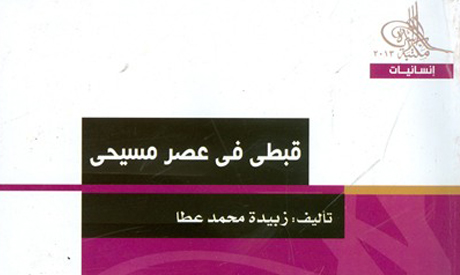
'A Copt in a Christian Er') by Zubeida Mohammed Atta (Photo: Other)
Qibti fi 'Asr Massihi (A Copt in a Christian Era) by Zubeida Mohamed Atta, General Egyptian Book Organisation, Family Library, Cairo, 2013. pp.379
A Copt in a Christian Era is perhaps among the most important books recently published by the General Egyptian Book Organisation (GEBO), for the authoress has relied on a large number of papyrus manuscripts spanning centuries – from the Ptolemaic rule of Egypt, through Roman and Byzantine occupation and up to the Muslim conquest – and constituting veritable watershed periods in Egyptian history.
The book title alludes to the fact that "Copt" does not point to a religious affiliation, since it historically precedes the emergence of Christianity. According to the authoress' words, Coptic Egypt "is the Egyptian Egypt; Egypt of the ordinary people. It isn't marked by a specific period that we can put a beginning and an end to. The people remained, whether under Greek or Roman rule, Egyptian."
As the first century AD heralded the emergence of Christianity in Egypt, the authoress focuses on the fusion that ensued between three diverse worlds: Ancient Egyptian, Greek and Christian. Greek culture recognised the Ancient Egyptian religion, was influenced by it and eventually merged into its frame. Egyptian gods had been acknowledged and venerated since Alexander the Great, even before the Ptolemaic reign. The Egyptian Christian caught in the transitional period, on the other hand, could neither erase the past in which he was born, nor reconcile it with his present.
And yet, the renowned Fayoum portraits demonstrate the continuity that still marks Egyptian history: the features are Egyptian, the robes Greek, while the dead – drawn between Anubis and Osiris – clutches an Ankh (Pharaonic key of life) transformed into the cross of Christ. The modern Egyptian similarly carries a historic cumulative memory allowing him to preserve the Ancient Egyptian, Christian and Islamic essence within his psyche.
Medieval Studies professor Dr. Zubeida Mohamed Atta asserts that Egyptians maintained this historic cumulative aspect despite having successfully replaced their Pharaonic religion with Christianity and then with Islam – along with their language, from Ancient Egyptian to Coptic and then to Arabic.
As the writer examines the period which witnessed the language transform from Ancient Egyptian to Coptic, she finds the first Egyptian document to be transliterated to Greek letters dating nearly half a century before the birth of Jesus. Once Egyptian priests began to use it in their writings, individuals also started using Greek letters to write Egyptian -- and this before the advent of Christianity – thus sending the Coptic language into a new phase manifested in the discovery of Coptic texts from the Pharaonic era proving that while the language remained Egyptian, the letters used to write it had become Greek.
Atta additionally observes that the Coptic language continued to be used by the average citizen beyond the Islamic conquest of Egypt in 641 AD. Coptic even remained the language of official correspondence until Governor Abdallah Ibn Abdel-Malek issued a decree in 706 AD dictating it be replaced by Arabic. The Coptic language, nevertheless, still remained in common usage among a large section of the population, as evidenced by the words of the famous 15th century Arab historian, Al-Maqrizi, in his documentation of Abbasid Caliph Al-Ma'mun's visit to Egypt: "He never walked without translators." Al-Maqrizi also mentioned that the Coptic language continued to exist during his own time, albeit on a narrow scale.
A similar conversion took place from the Ancient Egyptian religion to Christianity. For instance, notions of punishment and reward in the Afterlife, resurrection and the immortality of the spirit are common foundations for the two religions. The Holy Trinity in Christianity is also echoed by the Ancient Egyptian trinity – Horus, Isis and Osiris – while the idea of the Immaculate Conception is paralleled by the birth of the Ancient Egyptian god Apis. Horus as a young warrior striking the monster Set resembles the story of Saint Mar Girgis (St. George) slaying the dragon. Baptism with holy water exists in both religions and even monasticism was a familiar concept in Ancient Egyptian thought.
The 100 or so pages of the second chapter are entirely devoted to Alexandria, as though it were a separate book. Beginning with the city's foundation by Alexander the Macedonian, the chapter proceeds to examine its Greek, Roman and Byzantine features up until the emergence of Christianity. The authoress discusses the new religion's timid initial appearance, which was followed by skirmishes, then fierce battles pitting advocates of the new religion against those seeking to safeguard the worship of Ancient Egyptian gods.
Finally, the last chapter explores provincial social life during the aforementioned period. It reviews the peasants' rural lifestyle in villages, the arts, the authorities and general human activity within in the Christian era.
As the reader is led by the writer to examine layers of thought, ideology, religion and little known aspects of bygone Egyptian social life, the research proves a truly enjoyable, and enlightening, journey through Egypt's history.
Short link: